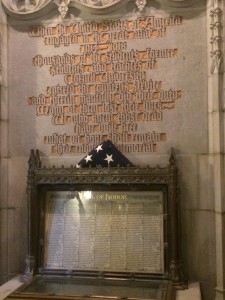On October 3rd, instead of staying in all day and watching Mean Girls, I went to take a tour with the rest of the Rose Scholars around West Campus. I was originally intrigued by this event because I had no idea there were any secret tunnels around Cornell (spare for the one that connects Olin and Uris libraries…) and really wanted to know where they were.
Professor Blalock gathered us in the Rose Common Room and took us to Noyes. Originally, I didn’t think there was anything too secretive about Noyes — I went to the gym there a few times this year and I’ve seen the rock wall before, but I was pretty surprised to see the basketball and volleyball court right below me. In addition, the staff there let us know that every other Tuesday, Noyes has a spa night, where students can get free manicures, massages, and food! Did I mention it was all free? I might have to take a stop there one night.
After Noyes, we all gathered around Baker Flagpole, where Garrick told us about the history of the West Campus Housing System. In addition to the other Gothic buildings at the base of the slope, there are the two War Memorials — Lyon Hall for the army and McFaddin Hall for the navy — built by the Quill and Dagger Society, commemorated to those who lost their lives in World War I. These War Memorials used to be open to the public but are now kept under lock and key, preserved by the Cornell ROTC program.
(I also learned some insights about the Quill and Dagger Society, Cornell’s secret society. I was really intrigued to learn that the society meets at the top of Lyon Hall, which I could easily access through my dorm. But unless I don’t want to be eligible for the tapping class for my senior year, I can’t go up and visit the meeting room without having an escort. Still, it makes it not so secretive to know a little bit more.)
Finally, before Garrick took us through the tunnel that connects Rose House and Becker House, he told us a little more about the history of the West Campus housing system. Originally, when west campus dormitories were being built, there were plans to have Gothic buildings all over the area, but then the builders ran out of money. So instead, around the 1950s, mobile buildings were used as temporary student living, which I’ll bet didn’t really blend with the Gothic architecture at the base of the slope. It was only around ten years ago when the housing system was initiated to bring the communities closer together through integrated houses — Flora Rose being the youngest house and Alice Cook being the oldest. Garrick also told us how strange it was to have the houses named after Cornell professors instead of donors or famous presidents, something I haven’t realized before. I found this to be interesting as well, since I try to look at the inscriptions of the professors along the sides of the houses regularly.
I was glad to see that there was more than meets the eye to West Campus. This tour made me even more glad that I was able to move into such a finely woven, intricate community.

